Importance of Moving and Exploring in Early Years
VerifiedAdded on 2023/01/19
|8
|2424
|89
AI Summary
This article discusses the significance of moving and exploring in the early years of life for cognitive, physical, social, and emotional development. It explores Gallahue’s hour glass model and its impact on children's growth. The article emphasizes the importance of a caring and supportive environment in promoting optimal development.
Contribute Materials
Your contribution can guide someone’s learning journey. Share your
documents today.
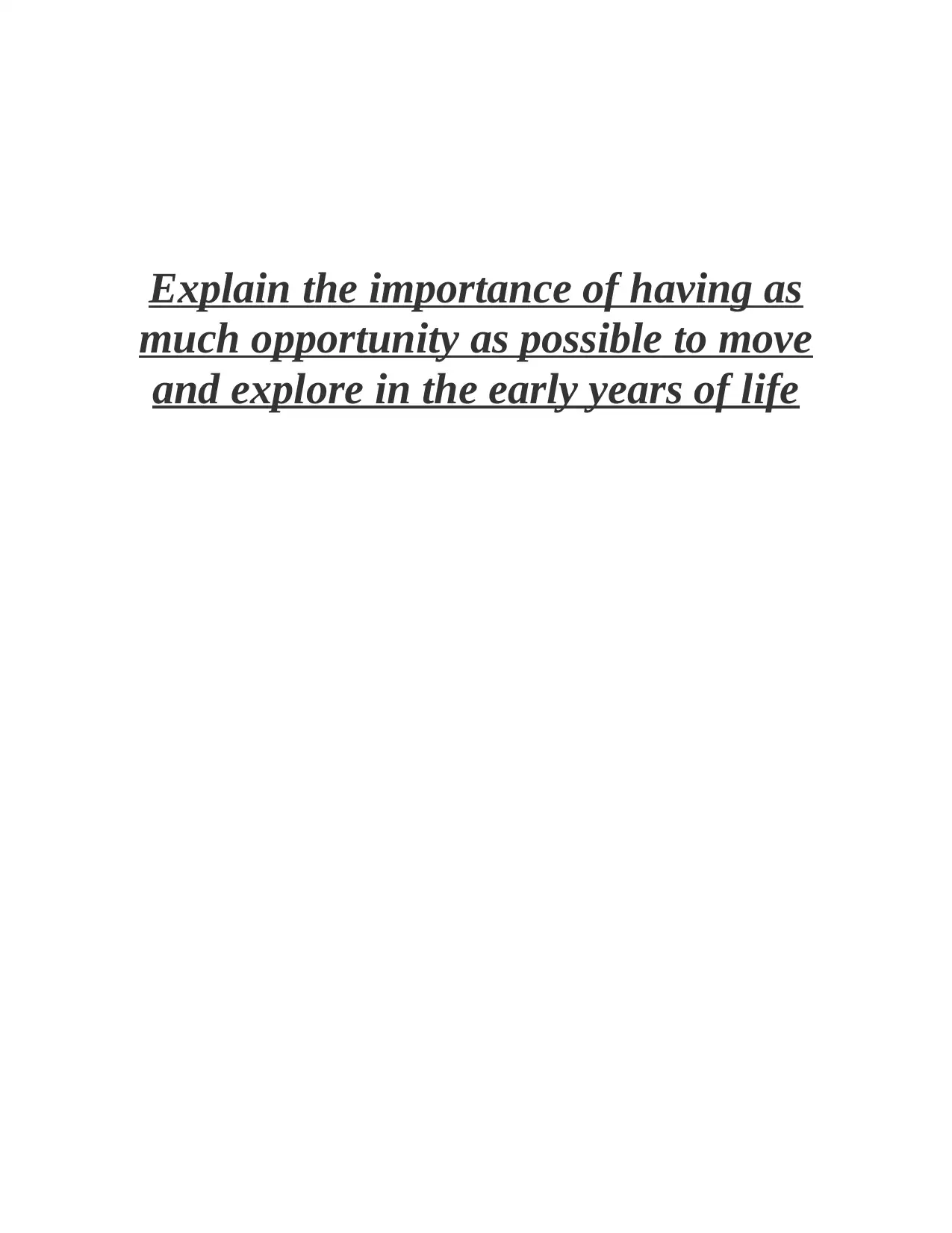
Explain the importance of having as
much opportunity as possible to move
and explore in the early years of life
much opportunity as possible to move
and explore in the early years of life
Secure Best Marks with AI Grader
Need help grading? Try our AI Grader for instant feedback on your assignments.
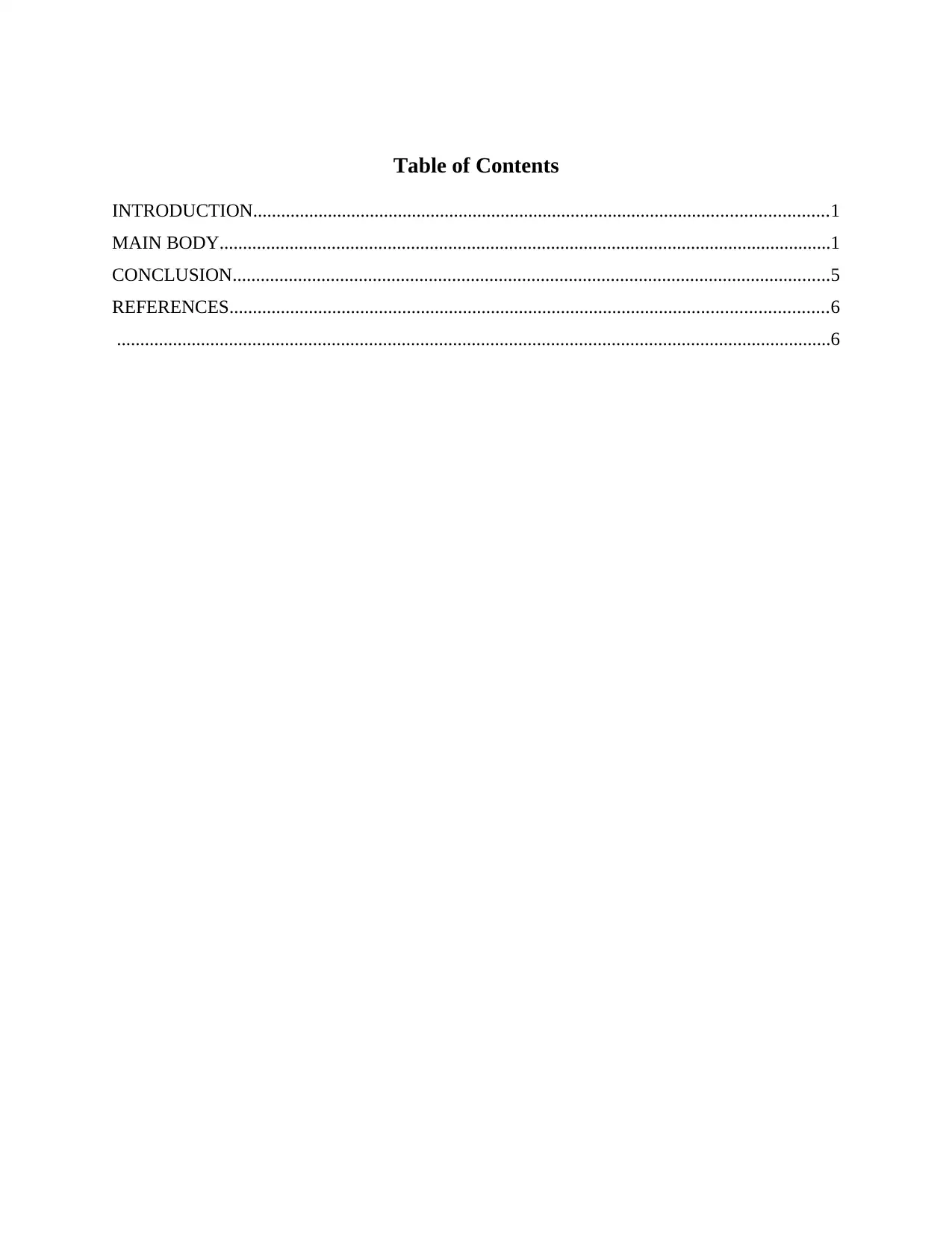
Table of Contents
INTRODUCTION...........................................................................................................................1
MAIN BODY...................................................................................................................................1
CONCLUSION................................................................................................................................5
REFERENCES................................................................................................................................6
.........................................................................................................................................................6
INTRODUCTION...........................................................................................................................1
MAIN BODY...................................................................................................................................1
CONCLUSION................................................................................................................................5
REFERENCES................................................................................................................................6
.........................................................................................................................................................6
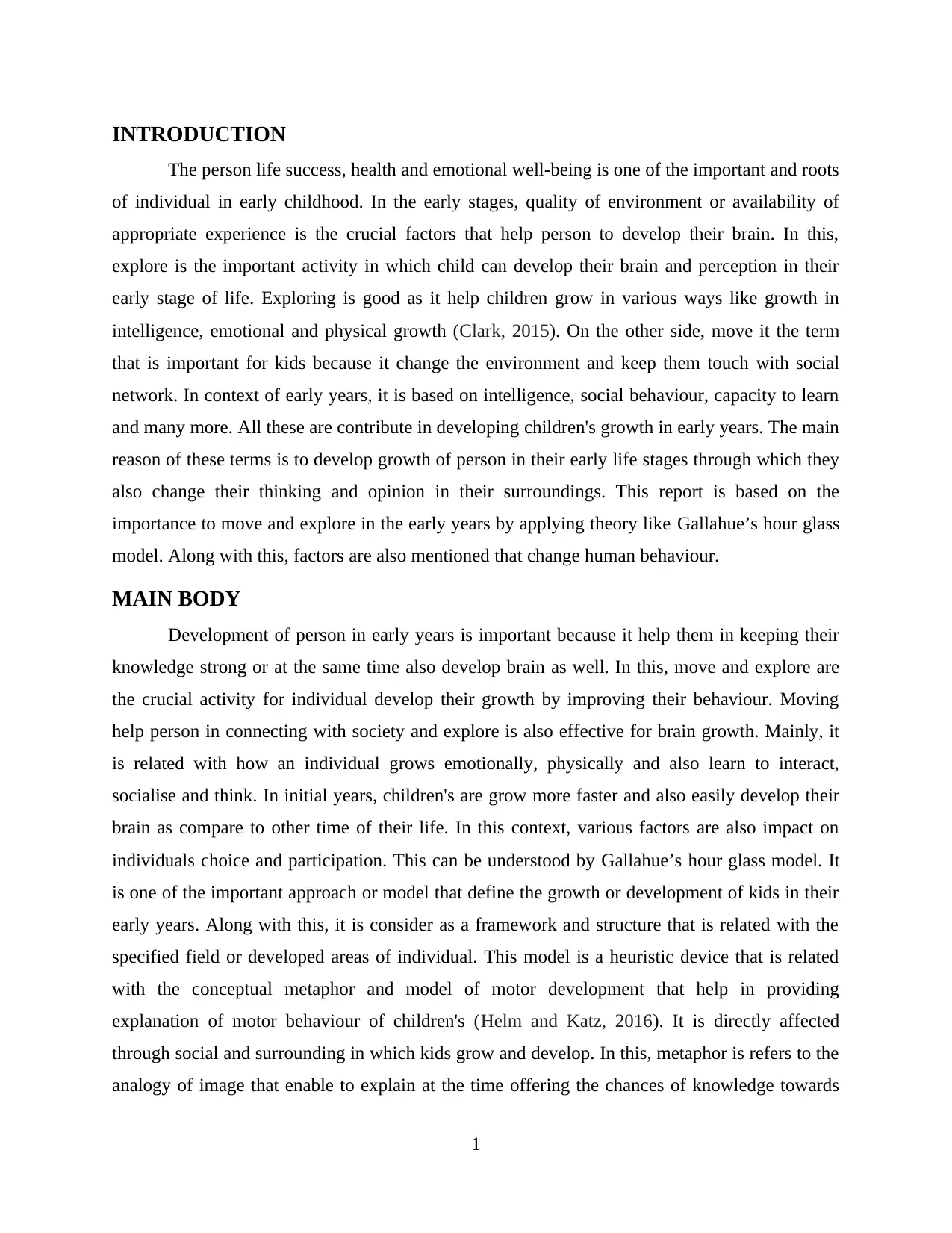
INTRODUCTION
The person life success, health and emotional well-being is one of the important and roots
of individual in early childhood. In the early stages, quality of environment or availability of
appropriate experience is the crucial factors that help person to develop their brain. In this,
explore is the important activity in which child can develop their brain and perception in their
early stage of life. Exploring is good as it help children grow in various ways like growth in
intelligence, emotional and physical growth (Clark, 2015). On the other side, move it the term
that is important for kids because it change the environment and keep them touch with social
network. In context of early years, it is based on intelligence, social behaviour, capacity to learn
and many more. All these are contribute in developing children's growth in early years. The main
reason of these terms is to develop growth of person in their early life stages through which they
also change their thinking and opinion in their surroundings. This report is based on the
importance to move and explore in the early years by applying theory like Gallahue’s hour glass
model. Along with this, factors are also mentioned that change human behaviour.
MAIN BODY
Development of person in early years is important because it help them in keeping their
knowledge strong or at the same time also develop brain as well. In this, move and explore are
the crucial activity for individual develop their growth by improving their behaviour. Moving
help person in connecting with society and explore is also effective for brain growth. Mainly, it
is related with how an individual grows emotionally, physically and also learn to interact,
socialise and think. In initial years, children's are grow more faster and also easily develop their
brain as compare to other time of their life. In this context, various factors are also impact on
individuals choice and participation. This can be understood by Gallahue’s hour glass model. It
is one of the important approach or model that define the growth or development of kids in their
early years. Along with this, it is consider as a framework and structure that is related with the
specified field or developed areas of individual. This model is a heuristic device that is related
with the conceptual metaphor and model of motor development that help in providing
explanation of motor behaviour of children's (Helm and Katz, 2016). It is directly affected
through social and surrounding in which kids grow and develop. In this, metaphor is refers to the
analogy of image that enable to explain at the time offering the chances of knowledge towards
1
The person life success, health and emotional well-being is one of the important and roots
of individual in early childhood. In the early stages, quality of environment or availability of
appropriate experience is the crucial factors that help person to develop their brain. In this,
explore is the important activity in which child can develop their brain and perception in their
early stage of life. Exploring is good as it help children grow in various ways like growth in
intelligence, emotional and physical growth (Clark, 2015). On the other side, move it the term
that is important for kids because it change the environment and keep them touch with social
network. In context of early years, it is based on intelligence, social behaviour, capacity to learn
and many more. All these are contribute in developing children's growth in early years. The main
reason of these terms is to develop growth of person in their early life stages through which they
also change their thinking and opinion in their surroundings. This report is based on the
importance to move and explore in the early years by applying theory like Gallahue’s hour glass
model. Along with this, factors are also mentioned that change human behaviour.
MAIN BODY
Development of person in early years is important because it help them in keeping their
knowledge strong or at the same time also develop brain as well. In this, move and explore are
the crucial activity for individual develop their growth by improving their behaviour. Moving
help person in connecting with society and explore is also effective for brain growth. Mainly, it
is related with how an individual grows emotionally, physically and also learn to interact,
socialise and think. In initial years, children's are grow more faster and also easily develop their
brain as compare to other time of their life. In this context, various factors are also impact on
individuals choice and participation. This can be understood by Gallahue’s hour glass model. It
is one of the important approach or model that define the growth or development of kids in their
early years. Along with this, it is consider as a framework and structure that is related with the
specified field or developed areas of individual. This model is a heuristic device that is related
with the conceptual metaphor and model of motor development that help in providing
explanation of motor behaviour of children's (Helm and Katz, 2016). It is directly affected
through social and surrounding in which kids grow and develop. In this, metaphor is refers to the
analogy of image that enable to explain at the time offering the chances of knowledge towards
1
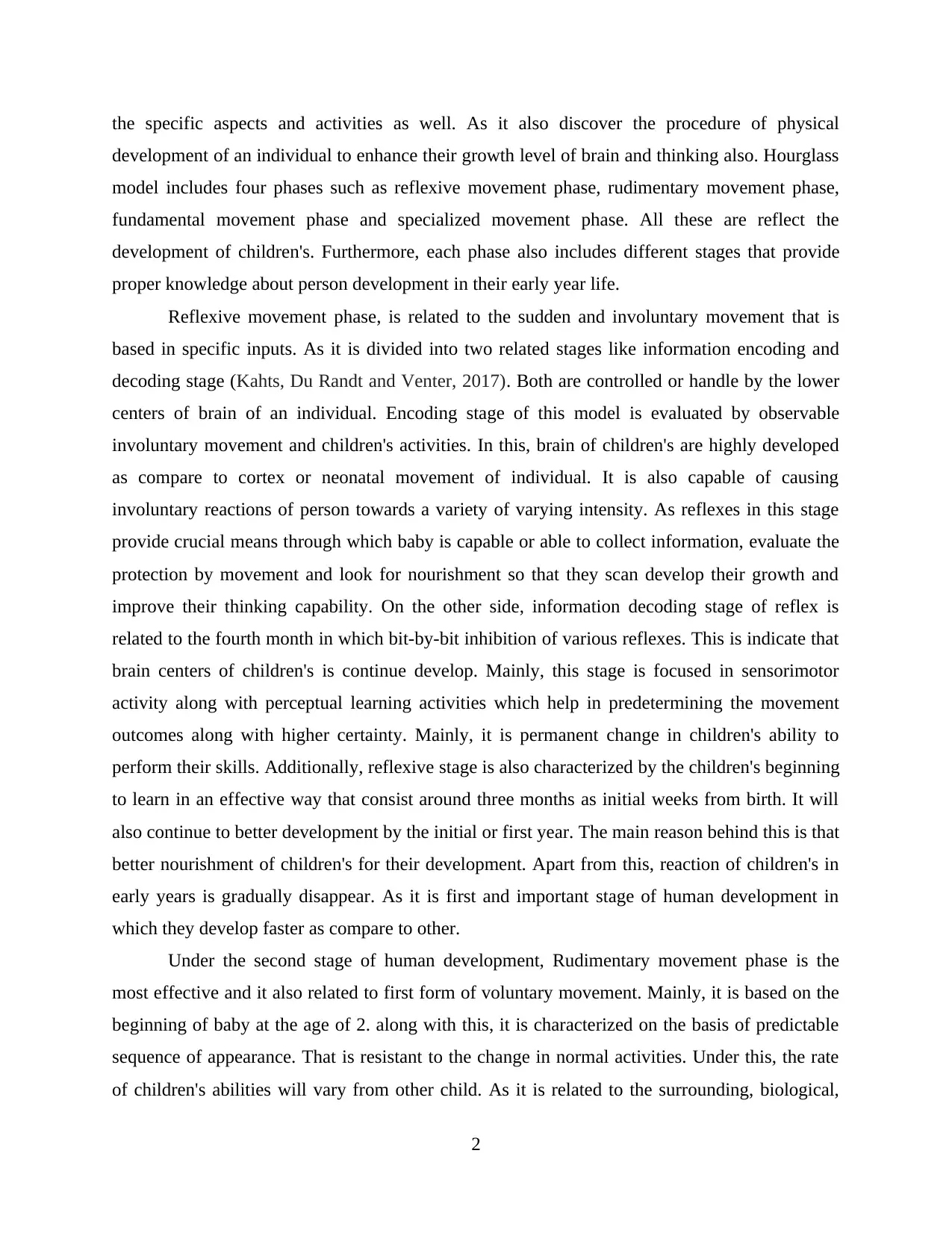
the specific aspects and activities as well. As it also discover the procedure of physical
development of an individual to enhance their growth level of brain and thinking also. Hourglass
model includes four phases such as reflexive movement phase, rudimentary movement phase,
fundamental movement phase and specialized movement phase. All these are reflect the
development of children's. Furthermore, each phase also includes different stages that provide
proper knowledge about person development in their early year life.
Reflexive movement phase, is related to the sudden and involuntary movement that is
based in specific inputs. As it is divided into two related stages like information encoding and
decoding stage (Kahts, Du Randt and Venter, 2017). Both are controlled or handle by the lower
centers of brain of an individual. Encoding stage of this model is evaluated by observable
involuntary movement and children's activities. In this, brain of children's are highly developed
as compare to cortex or neonatal movement of individual. It is also capable of causing
involuntary reactions of person towards a variety of varying intensity. As reflexes in this stage
provide crucial means through which baby is capable or able to collect information, evaluate the
protection by movement and look for nourishment so that they scan develop their growth and
improve their thinking capability. On the other side, information decoding stage of reflex is
related to the fourth month in which bit-by-bit inhibition of various reflexes. This is indicate that
brain centers of children's is continue develop. Mainly, this stage is focused in sensorimotor
activity along with perceptual learning activities which help in predetermining the movement
outcomes along with higher certainty. Mainly, it is permanent change in children's ability to
perform their skills. Additionally, reflexive stage is also characterized by the children's beginning
to learn in an effective way that consist around three months as initial weeks from birth. It will
also continue to better development by the initial or first year. The main reason behind this is that
better nourishment of children's for their development. Apart from this, reaction of children's in
early years is gradually disappear. As it is first and important stage of human development in
which they develop faster as compare to other.
Under the second stage of human development, Rudimentary movement phase is the
most effective and it also related to first form of voluntary movement. Mainly, it is based on the
beginning of baby at the age of 2. along with this, it is characterized on the basis of predictable
sequence of appearance. That is resistant to the change in normal activities. Under this, the rate
of children's abilities will vary from other child. As it is related to the surrounding, biological,
2
development of an individual to enhance their growth level of brain and thinking also. Hourglass
model includes four phases such as reflexive movement phase, rudimentary movement phase,
fundamental movement phase and specialized movement phase. All these are reflect the
development of children's. Furthermore, each phase also includes different stages that provide
proper knowledge about person development in their early year life.
Reflexive movement phase, is related to the sudden and involuntary movement that is
based in specific inputs. As it is divided into two related stages like information encoding and
decoding stage (Kahts, Du Randt and Venter, 2017). Both are controlled or handle by the lower
centers of brain of an individual. Encoding stage of this model is evaluated by observable
involuntary movement and children's activities. In this, brain of children's are highly developed
as compare to cortex or neonatal movement of individual. It is also capable of causing
involuntary reactions of person towards a variety of varying intensity. As reflexes in this stage
provide crucial means through which baby is capable or able to collect information, evaluate the
protection by movement and look for nourishment so that they scan develop their growth and
improve their thinking capability. On the other side, information decoding stage of reflex is
related to the fourth month in which bit-by-bit inhibition of various reflexes. This is indicate that
brain centers of children's is continue develop. Mainly, this stage is focused in sensorimotor
activity along with perceptual learning activities which help in predetermining the movement
outcomes along with higher certainty. Mainly, it is permanent change in children's ability to
perform their skills. Additionally, reflexive stage is also characterized by the children's beginning
to learn in an effective way that consist around three months as initial weeks from birth. It will
also continue to better development by the initial or first year. The main reason behind this is that
better nourishment of children's for their development. Apart from this, reaction of children's in
early years is gradually disappear. As it is first and important stage of human development in
which they develop faster as compare to other.
Under the second stage of human development, Rudimentary movement phase is the
most effective and it also related to first form of voluntary movement. Mainly, it is based on the
beginning of baby at the age of 2. along with this, it is characterized on the basis of predictable
sequence of appearance. That is resistant to the change in normal activities. Under this, the rate
of children's abilities will vary from other child. As it is related to the surrounding, biological,
2
Secure Best Marks with AI Grader
Need help grading? Try our AI Grader for instant feedback on your assignments.
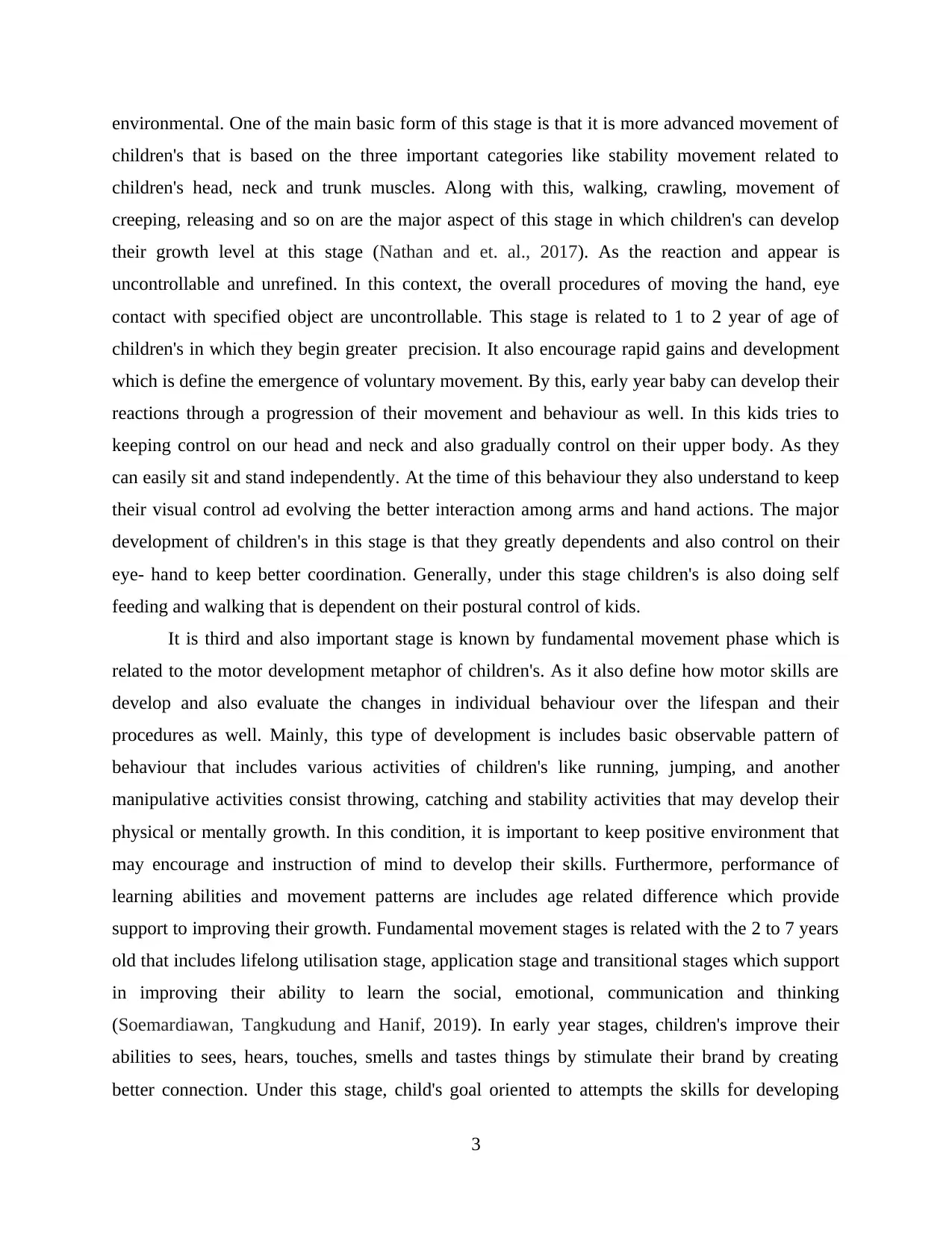
environmental. One of the main basic form of this stage is that it is more advanced movement of
children's that is based on the three important categories like stability movement related to
children's head, neck and trunk muscles. Along with this, walking, crawling, movement of
creeping, releasing and so on are the major aspect of this stage in which children's can develop
their growth level at this stage (Nathan and et. al., 2017). As the reaction and appear is
uncontrollable and unrefined. In this context, the overall procedures of moving the hand, eye
contact with specified object are uncontrollable. This stage is related to 1 to 2 year of age of
children's in which they begin greater precision. It also encourage rapid gains and development
which is define the emergence of voluntary movement. By this, early year baby can develop their
reactions through a progression of their movement and behaviour as well. In this kids tries to
keeping control on our head and neck and also gradually control on their upper body. As they
can easily sit and stand independently. At the time of this behaviour they also understand to keep
their visual control ad evolving the better interaction among arms and hand actions. The major
development of children's in this stage is that they greatly dependents and also control on their
eye- hand to keep better coordination. Generally, under this stage children's is also doing self
feeding and walking that is dependent on their postural control of kids.
It is third and also important stage is known by fundamental movement phase which is
related to the motor development metaphor of children's. As it also define how motor skills are
develop and also evaluate the changes in individual behaviour over the lifespan and their
procedures as well. Mainly, this type of development is includes basic observable pattern of
behaviour that includes various activities of children's like running, jumping, and another
manipulative activities consist throwing, catching and stability activities that may develop their
physical or mentally growth. In this condition, it is important to keep positive environment that
may encourage and instruction of mind to develop their skills. Furthermore, performance of
learning abilities and movement patterns are includes age related difference which provide
support to improving their growth. Fundamental movement stages is related with the 2 to 7 years
old that includes lifelong utilisation stage, application stage and transitional stages which support
in improving their ability to learn the social, emotional, communication and thinking
(Soemardiawan, Tangkudung and Hanif, 2019). In early year stages, children's improve their
abilities to sees, hears, touches, smells and tastes things by stimulate their brand by creating
better connection. Under this stage, child's goal oriented to attempts the skills for developing
3
children's that is based on the three important categories like stability movement related to
children's head, neck and trunk muscles. Along with this, walking, crawling, movement of
creeping, releasing and so on are the major aspect of this stage in which children's can develop
their growth level at this stage (Nathan and et. al., 2017). As the reaction and appear is
uncontrollable and unrefined. In this context, the overall procedures of moving the hand, eye
contact with specified object are uncontrollable. This stage is related to 1 to 2 year of age of
children's in which they begin greater precision. It also encourage rapid gains and development
which is define the emergence of voluntary movement. By this, early year baby can develop their
reactions through a progression of their movement and behaviour as well. In this kids tries to
keeping control on our head and neck and also gradually control on their upper body. As they
can easily sit and stand independently. At the time of this behaviour they also understand to keep
their visual control ad evolving the better interaction among arms and hand actions. The major
development of children's in this stage is that they greatly dependents and also control on their
eye- hand to keep better coordination. Generally, under this stage children's is also doing self
feeding and walking that is dependent on their postural control of kids.
It is third and also important stage is known by fundamental movement phase which is
related to the motor development metaphor of children's. As it also define how motor skills are
develop and also evaluate the changes in individual behaviour over the lifespan and their
procedures as well. Mainly, this type of development is includes basic observable pattern of
behaviour that includes various activities of children's like running, jumping, and another
manipulative activities consist throwing, catching and stability activities that may develop their
physical or mentally growth. In this condition, it is important to keep positive environment that
may encourage and instruction of mind to develop their skills. Furthermore, performance of
learning abilities and movement patterns are includes age related difference which provide
support to improving their growth. Fundamental movement stages is related with the 2 to 7 years
old that includes lifelong utilisation stage, application stage and transitional stages which support
in improving their ability to learn the social, emotional, communication and thinking
(Soemardiawan, Tangkudung and Hanif, 2019). In early year stages, children's improve their
abilities to sees, hears, touches, smells and tastes things by stimulate their brand by creating
better connection. Under this stage, child's goal oriented to attempts the skills for developing
3
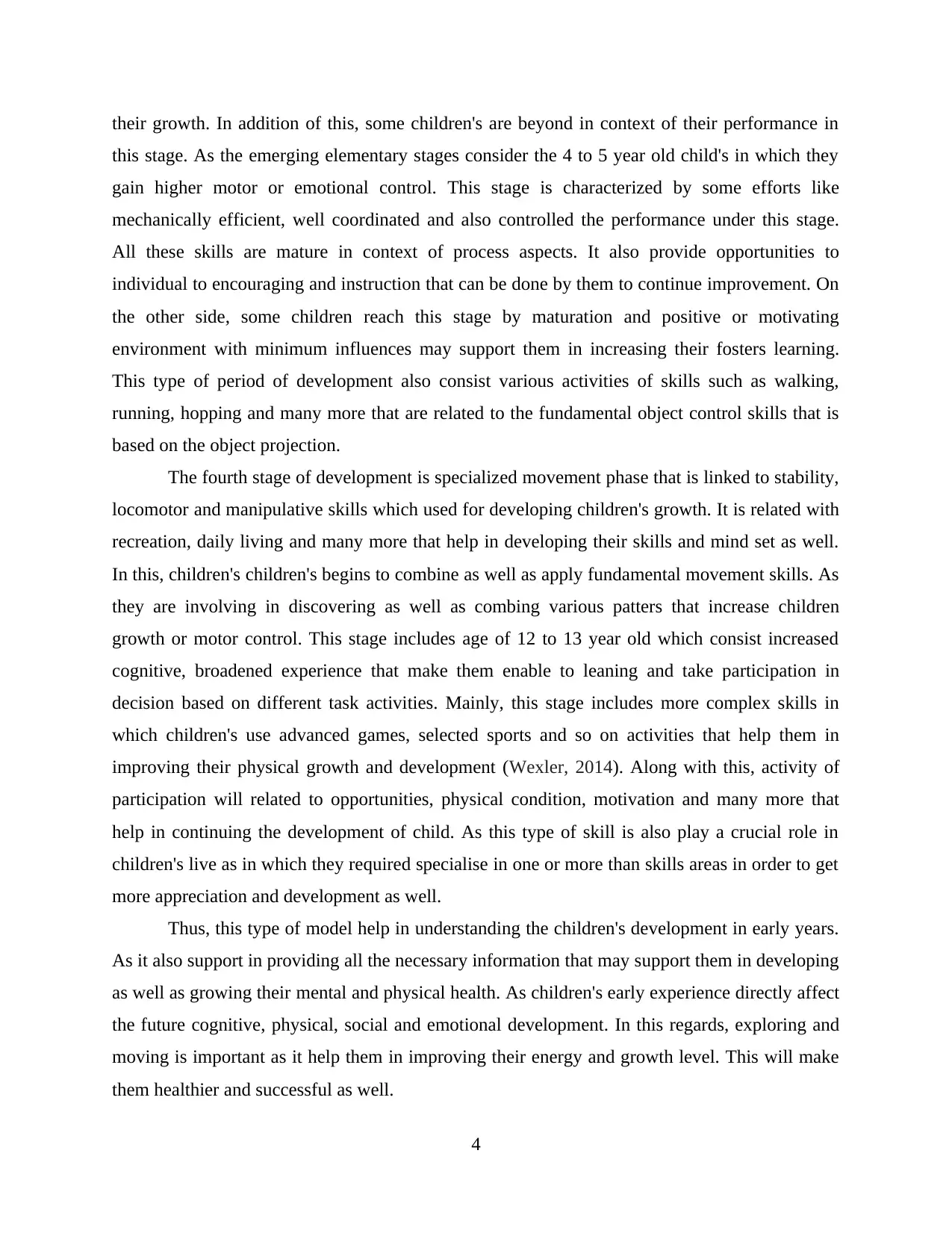
their growth. In addition of this, some children's are beyond in context of their performance in
this stage. As the emerging elementary stages consider the 4 to 5 year old child's in which they
gain higher motor or emotional control. This stage is characterized by some efforts like
mechanically efficient, well coordinated and also controlled the performance under this stage.
All these skills are mature in context of process aspects. It also provide opportunities to
individual to encouraging and instruction that can be done by them to continue improvement. On
the other side, some children reach this stage by maturation and positive or motivating
environment with minimum influences may support them in increasing their fosters learning.
This type of period of development also consist various activities of skills such as walking,
running, hopping and many more that are related to the fundamental object control skills that is
based on the object projection.
The fourth stage of development is specialized movement phase that is linked to stability,
locomotor and manipulative skills which used for developing children's growth. It is related with
recreation, daily living and many more that help in developing their skills and mind set as well.
In this, children's children's begins to combine as well as apply fundamental movement skills. As
they are involving in discovering as well as combing various patters that increase children
growth or motor control. This stage includes age of 12 to 13 year old which consist increased
cognitive, broadened experience that make them enable to leaning and take participation in
decision based on different task activities. Mainly, this stage includes more complex skills in
which children's use advanced games, selected sports and so on activities that help them in
improving their physical growth and development (Wexler, 2014). Along with this, activity of
participation will related to opportunities, physical condition, motivation and many more that
help in continuing the development of child. As this type of skill is also play a crucial role in
children's live as in which they required specialise in one or more than skills areas in order to get
more appreciation and development as well.
Thus, this type of model help in understanding the children's development in early years.
As it also support in providing all the necessary information that may support them in developing
as well as growing their mental and physical health. As children's early experience directly affect
the future cognitive, physical, social and emotional development. In this regards, exploring and
moving is important as it help them in improving their energy and growth level. This will make
them healthier and successful as well.
4
this stage. As the emerging elementary stages consider the 4 to 5 year old child's in which they
gain higher motor or emotional control. This stage is characterized by some efforts like
mechanically efficient, well coordinated and also controlled the performance under this stage.
All these skills are mature in context of process aspects. It also provide opportunities to
individual to encouraging and instruction that can be done by them to continue improvement. On
the other side, some children reach this stage by maturation and positive or motivating
environment with minimum influences may support them in increasing their fosters learning.
This type of period of development also consist various activities of skills such as walking,
running, hopping and many more that are related to the fundamental object control skills that is
based on the object projection.
The fourth stage of development is specialized movement phase that is linked to stability,
locomotor and manipulative skills which used for developing children's growth. It is related with
recreation, daily living and many more that help in developing their skills and mind set as well.
In this, children's children's begins to combine as well as apply fundamental movement skills. As
they are involving in discovering as well as combing various patters that increase children
growth or motor control. This stage includes age of 12 to 13 year old which consist increased
cognitive, broadened experience that make them enable to leaning and take participation in
decision based on different task activities. Mainly, this stage includes more complex skills in
which children's use advanced games, selected sports and so on activities that help them in
improving their physical growth and development (Wexler, 2014). Along with this, activity of
participation will related to opportunities, physical condition, motivation and many more that
help in continuing the development of child. As this type of skill is also play a crucial role in
children's live as in which they required specialise in one or more than skills areas in order to get
more appreciation and development as well.
Thus, this type of model help in understanding the children's development in early years.
As it also support in providing all the necessary information that may support them in developing
as well as growing their mental and physical health. As children's early experience directly affect
the future cognitive, physical, social and emotional development. In this regards, exploring and
moving is important as it help them in improving their energy and growth level. This will make
them healthier and successful as well.
4
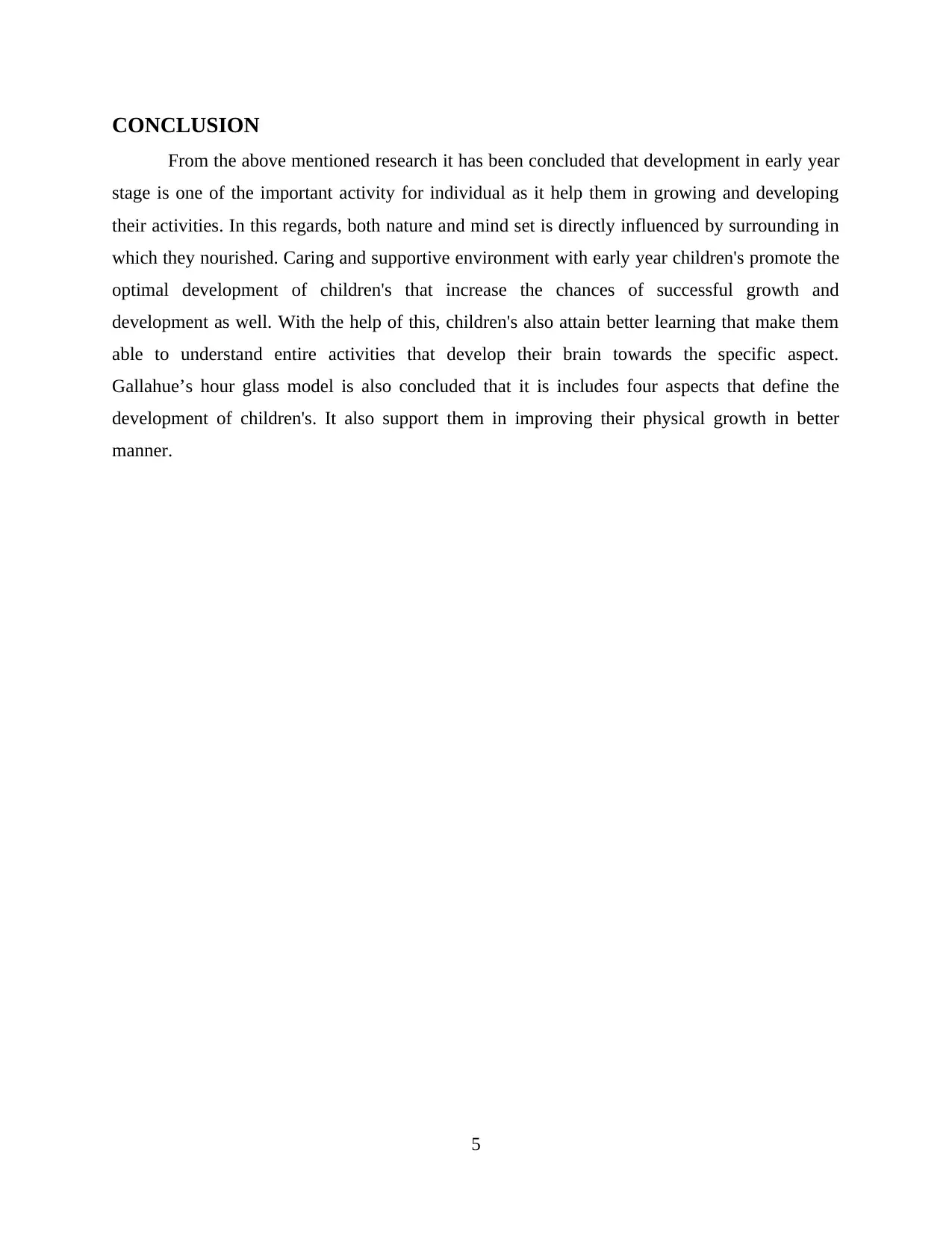
CONCLUSION
From the above mentioned research it has been concluded that development in early year
stage is one of the important activity for individual as it help them in growing and developing
their activities. In this regards, both nature and mind set is directly influenced by surrounding in
which they nourished. Caring and supportive environment with early year children's promote the
optimal development of children's that increase the chances of successful growth and
development as well. With the help of this, children's also attain better learning that make them
able to understand entire activities that develop their brain towards the specific aspect.
Gallahue’s hour glass model is also concluded that it is includes four aspects that define the
development of children's. It also support them in improving their physical growth in better
manner.
5
From the above mentioned research it has been concluded that development in early year
stage is one of the important activity for individual as it help them in growing and developing
their activities. In this regards, both nature and mind set is directly influenced by surrounding in
which they nourished. Caring and supportive environment with early year children's promote the
optimal development of children's that increase the chances of successful growth and
development as well. With the help of this, children's also attain better learning that make them
able to understand entire activities that develop their brain towards the specific aspect.
Gallahue’s hour glass model is also concluded that it is includes four aspects that define the
development of children's. It also support them in improving their physical growth in better
manner.
5
Paraphrase This Document
Need a fresh take? Get an instant paraphrase of this document with our AI Paraphraser
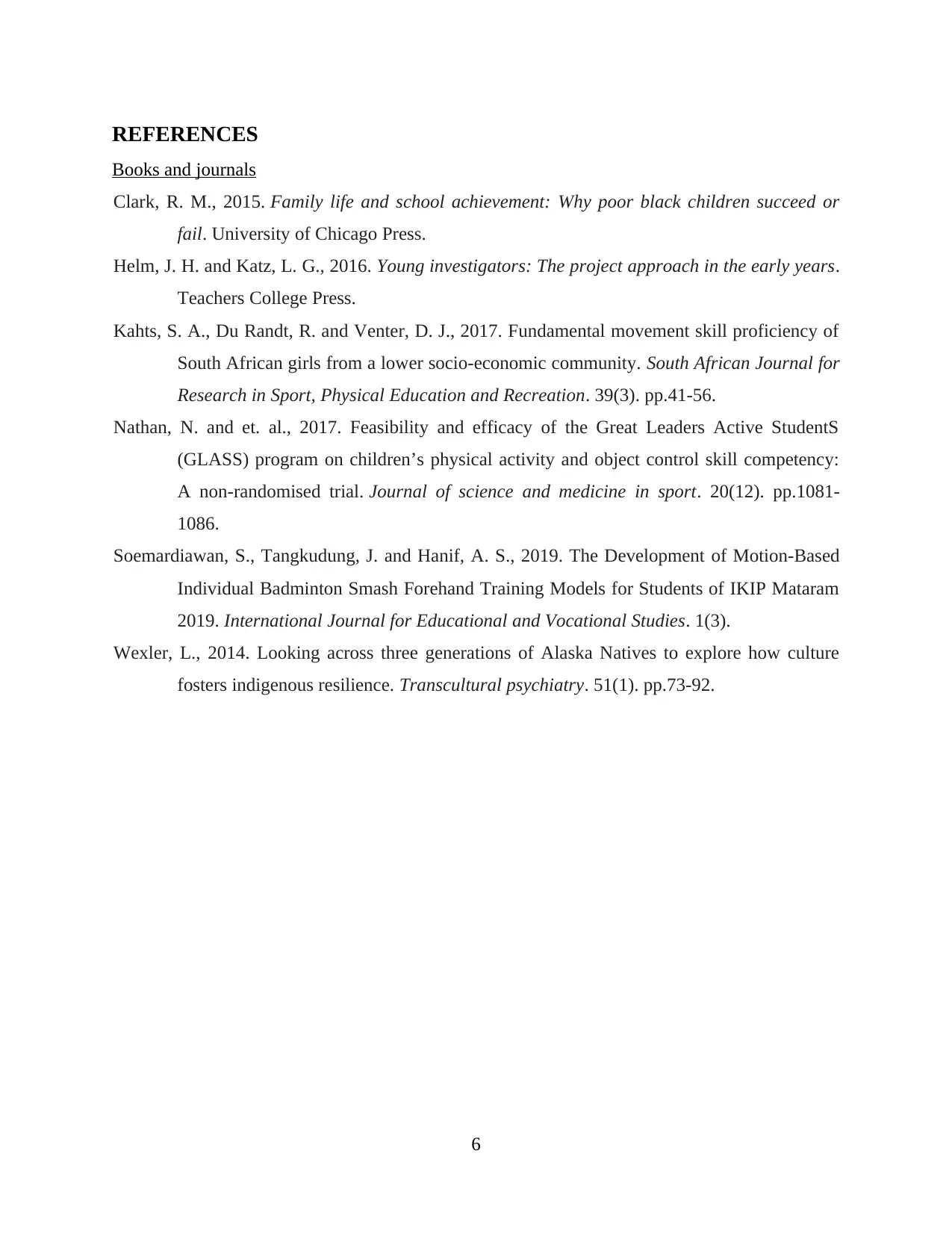
REFERENCES
Books and journals
Clark, R. M., 2015. Family life and school achievement: Why poor black children succeed or
fail. University of Chicago Press.
Helm, J. H. and Katz, L. G., 2016. Young investigators: The project approach in the early years.
Teachers College Press.
Kahts, S. A., Du Randt, R. and Venter, D. J., 2017. Fundamental movement skill proficiency of
South African girls from a lower socio-economic community. South African Journal for
Research in Sport, Physical Education and Recreation. 39(3). pp.41-56.
Nathan, N. and et. al., 2017. Feasibility and efficacy of the Great Leaders Active StudentS
(GLASS) program on children’s physical activity and object control skill competency:
A non-randomised trial. Journal of science and medicine in sport. 20(12). pp.1081-
1086.
Soemardiawan, S., Tangkudung, J. and Hanif, A. S., 2019. The Development of Motion-Based
Individual Badminton Smash Forehand Training Models for Students of IKIP Mataram
2019. International Journal for Educational and Vocational Studies. 1(3).
Wexler, L., 2014. Looking across three generations of Alaska Natives to explore how culture
fosters indigenous resilience. Transcultural psychiatry. 51(1). pp.73-92.
6
Books and journals
Clark, R. M., 2015. Family life and school achievement: Why poor black children succeed or
fail. University of Chicago Press.
Helm, J. H. and Katz, L. G., 2016. Young investigators: The project approach in the early years.
Teachers College Press.
Kahts, S. A., Du Randt, R. and Venter, D. J., 2017. Fundamental movement skill proficiency of
South African girls from a lower socio-economic community. South African Journal for
Research in Sport, Physical Education and Recreation. 39(3). pp.41-56.
Nathan, N. and et. al., 2017. Feasibility and efficacy of the Great Leaders Active StudentS
(GLASS) program on children’s physical activity and object control skill competency:
A non-randomised trial. Journal of science and medicine in sport. 20(12). pp.1081-
1086.
Soemardiawan, S., Tangkudung, J. and Hanif, A. S., 2019. The Development of Motion-Based
Individual Badminton Smash Forehand Training Models for Students of IKIP Mataram
2019. International Journal for Educational and Vocational Studies. 1(3).
Wexler, L., 2014. Looking across three generations of Alaska Natives to explore how culture
fosters indigenous resilience. Transcultural psychiatry. 51(1). pp.73-92.
6
1 out of 8
Related Documents
Your All-in-One AI-Powered Toolkit for Academic Success.
+13062052269
info@desklib.com
Available 24*7 on WhatsApp / Email
![[object Object]](/_next/static/media/star-bottom.7253800d.svg)
Unlock your academic potential
© 2024 | Zucol Services PVT LTD | All rights reserved.





